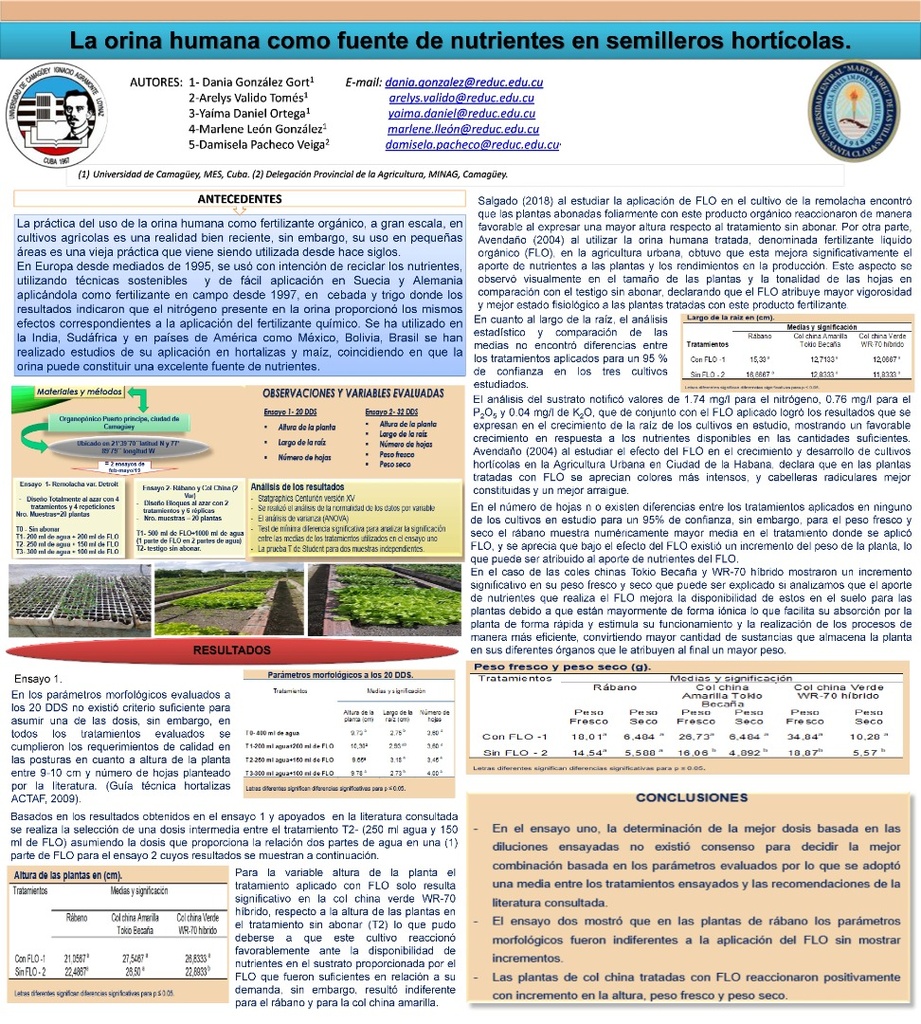Executive Secretary

10th International Scientific Conference on Agricultural Development and SustainabilityAGROCENTRO 2023
Agrocentro 2021

Abstract
Human urine was studied as an organic liquid fertilizer (FLO) for the production of quality horticultural postures in the organoponic Port-au-Prince in the city of Camagüey. Two trials were conducted, the first with the aim of obtaining the best dose for which a completely random design was used with four repetitions where the treatments were different dilutions of the FLO in water and an unfertilized control applied before planting in the beet crop. The second trial, with the aim of obtaining the postures, was mounted on a random block design with six replicates where one part of FLO was applied in two parts of water ten days after planting as a single dose. Morphological parameters of the treated plants were evaluated regarding the unpaid witness in radish and Chinese cabbage. The safety of the urine was certified and the soil institute determined the nutrient contents N, P and K of the substrate and the FLO and pH, by Cuban standards. To choose the best dose based on the dilutions tested there was no conclusive evidence due to the lack of communion in the best results of the evaluated parameters. The radish had no response with the application of the FLO while the Chinese cabbage treated with FLO reacted with increased height, fresh weight and dry weight. The statistical analysis was performed with the program Statgraphics Centurion version XV.
Resumen
Se estudió la orina humana como fertilizante liquido orgánico (FLO) para producción de posturas hortícolas de calidad en el organopónico Puerto Príncipe en la ciudad de Camagüey. Se realizaron dos ensayos, el primero con el objetivo de obtener la mejor dosis para lo que se utilizó un diseño completamente al azar con cuatro repeticiones donde los tratamientos fueron diferentes diluciones del FLO en agua y un testigo sin fertilizar aplicados antes de la siembra en el cultivo de la remolacha. El segundo ensayo, con el objetivo de obtener las posturas, se montó en un diseño de bloques al azar con seis replicas donde se aplicó una parte de FLO en dos partes de agua diez días después de la siembra como dosis única. Se evaluaron parámetros morfológicos de las plantas tratadas respecto al testigo sin abonar en rábano y col china. Se certificó la inocuidad de la orina y en el instituto de suelos se determinaron los contenidos de nutrientes N, P y K del sustrato y del FLO y el pH, por las normas cubanas. Para elegir la mejor dosis basada en las diluciones ensayadas no hubo evidencias conclusivas debido a la falta de comunión en los mejores resultados de los parámetros evaluados. El rábano no tuvo respuesta con la aplicación del FLO mientras la col china tratada con FLO reaccionó con incremento en la altura, peso fresco y peso seco. El análisis estadístico se realizó con el programa Statgraphics Centurión versión XV.
About The Speaker

MsC. Dania de la Caridad González Gort


